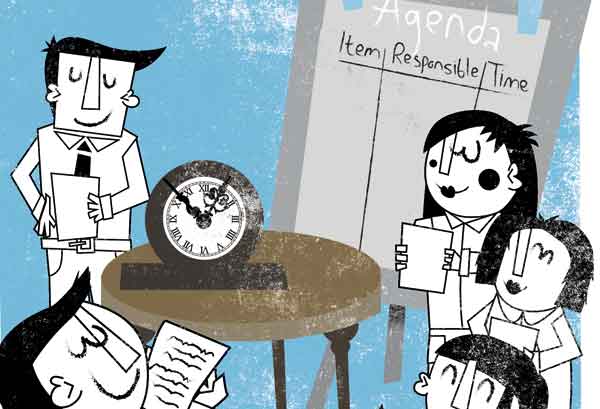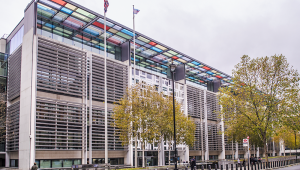By Phil Anderson | 1 June 2013 |
Public sector managers have to hold a lot of meetings but too few achieve their intended purpose – making good decisions based on the opinions of those present. Many lack structure and discipline and end up wasting everyone’s time. Here's how to ensure your meetings are productive

Meetings can be the bane of everyone’s lives. The public sector is full of them. Is this because some organisations have a culture of meetings for the sake of it? How often do you step out of one and exclaim that it was a waste of time? You might even ask, what is the point of having them at all?
But productive meetings should be at the core of the decision-making process. They should make the organisation more effective by motivating those who attend and making them feel like their voices have been heard. Among the essential requirements for a good meeting are: the points made should not have been laboured unnecessarily; a clear action plan should have been developed; and each agenda item took the expected amount of time.
If a meeting is poorly run and lacking structure and discipline, it is just a waste of time. It will also make vital participants reluctant to attend future meetings or be less inclined to contribute their valuable opinions.
The solution is simple. Meetings need a purpose, discipline and structure to make them run effectively.
They require a carefully prepared agenda, well-managed timekeeping, a reporting structure and an overall awareness of how meetings should be run.
If managers get a reputation for running meetings well, achieving worthwhile decisions and resolutions, and finishing on time or early, then they’ll achieve what we’re all looking for – productive meetings.
The following ten tips should help you become one of those managers.
1. Establish an objective
Have a clear reason for the meeting. Is it keeping up to date on the key performance indicators, or is it to discuss new ideas and approaches? What is the nature of the meeting? Make sure that the discussion and decisions being made could not be handled effectively outside the meeting. Avoid the temptation to meet just because it is Tuesday morning and you always have a meeting on Tuesday morning. Avoid those that don’t have a clear objective. They will not be productive.2. Agree an agenda
All meetings need some form of agenda. Build it by asking those who will be at the meeting to offer items for discussion. Determine what they want to achieve. Provide all the supporting information needed in advance to give people time to prepare. Also, make sure that the supporting information is as brief as possible, so people have a chance of reading it. Providing long papers during the meeting could waste valuable time as people won’t be able to digest them and concentrate on the meeting.3. Assign timings to agenda items
On the agenda, assign the name of the person to the subject they are bringing to the meeting and how much time they are going to need. Ensure the meeting starts and finishes on time and that every participant is punctual. This will give your meetings an enhanced sense of efficiency. It might be difficult at first to estimate how long an item needs, but this will get easier. Some organisations in the private sector have a ticker tape running showing what the meeting is costing in people hours.4. Nominate a time-keeper
The role of the time-keeper or ‘meeting czar’ is to keep everyone on time and the conversation on track. This doesn’t need to be the same person as the chair and the role can rotate at each meeting. Delegate the position if no-one volunteers.5. Use a One-minute warning
Use a xylophone or other fun alarm to alert each participant that they have one minute left of the allotted time on a particular agenda item. When the time is up, a tune could be played. If more time is needed, the meeting will then have to agree whether to take time away from later items on the agenda or shift that item to another day. Everyone needs to understand the reason for such timing interventions. Being productive requires discipline.6. Give everyone a voice
Use an item to indicate who is controlling the meeting. Whoever holds the pen, toy or whichever item happens to have been chosen, is the one who holds the floor. This gives everyone an opportunity to speak uninterrupted. Often, it is the loudest who get heard most clearly. This way everyone gets a chance. If someone else wants to speak they can ask for the pen – at which point the speaker will stop talking, or the chair may direct for the item to be passed on. Encourage participation in the discussion and decision-making process. It is a waste of time and resources to have people in a meeting if they do not contribute.7. Ensure follow-up action
Have a quick and easy-to-complete form that can be entered as the meeting progresses, so that when everyone returns to their desk they will find a list of actions. This simple action list need have only three columns ‘next steps’, ‘by whom’ and ‘by when’. This needs to be done at the time, in the room and sent out once the meeting is over. If there is friction at the end of the meeting it might not be politic to send it out immediately, but try to do so very soon after. This will help to ensure that the effective meeting is followed by effective action.8. leave time at the end to sum up
Allocate ten minutes at the end of the agenda to discuss benefits and concerns arising from the meeting. This is important. It does not have to be done at every meeting but should certainly be done periodically. Everyone should be able to offer a benefit and concern over the process of the meeting in terms of what went well and what didn’t. This is not about the decisions that were made, but about how they were made. This will result in continuous development of the meetings process which will be adapted to suit the people involved.9. Stand up and finish quicker
Have a stand-up meeting. Some organisations use this to get the business done more efficiently This removes the traditional comfort zone of the chair and table, making it more likely that people will talk less and get to the point quicker.10. Set out the Ground rules
A key factor in ensuring that meetings are a success is to maintain discipline throughout – all the way from the purpose, objectives and agenda to the way the way the meeting runs to time. These rules need to be discussed and agreed up-front and referred to when behaviour deviates from the norm.
Phil Anderson is a faculty member of Ashridge Business School specialising in leadership, and delivers a module, Effective Meetings, on the Management Development Programme
This article was first published in the June 2013 edition of Public Finance magazine



















